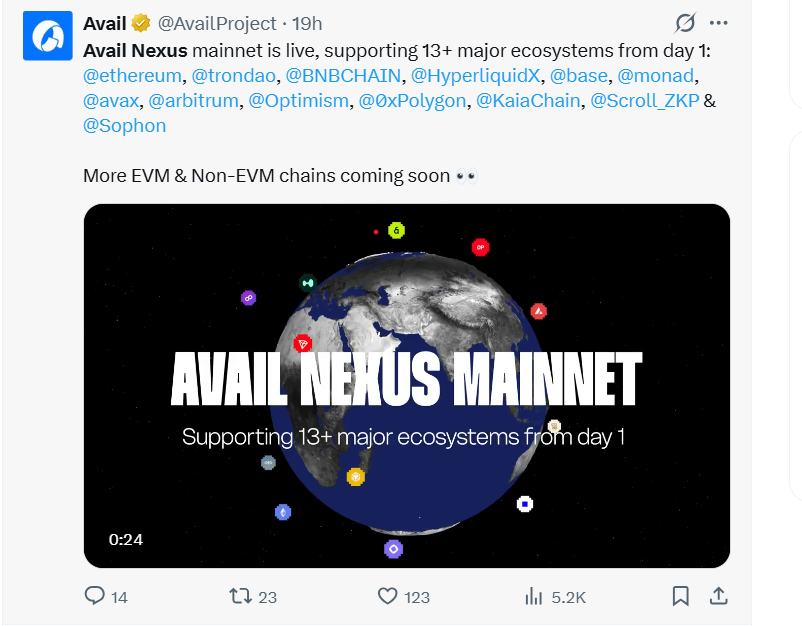The Avail Nexus mainnet launched this week, enabling seamless crosschain asset movement across 13 ecosystems by unifying balances and automating multi-step processes. This application-layer solution addresses fragmented liquidity and poor user experience in Web3, allowing users to specify intents and let solvers handle executions without bridging hassles.
-
Avail Nexus introduces intent-based execution to simplify crosschain interactions.
-
It creates unified balances, hiding complex plumbing like gas fees and routing from users.
-
Backed by secure vault contracts, it supports 13 blockchains with data availability verifiability, reducing risks in multichain environments.
Discover how Avail Nexus mainnet revolutionizes crosschain UX with unified balances and one-click flows. Explore seamless asset movement across 13 ecosystems today.
What is the Avail Nexus mainnet?
Avail Nexus mainnet is an innovative platform designed to streamline crosschain operations in the blockchain space. Launched this week, it operates at the application layer, providing developers with tools like software development kits and APIs to integrate multichain functionality into decentralized applications without modifying underlying protocols. By focusing on user intents rather than manual routing, it ensures efficient, secure asset transfers across diverse ecosystems.
How does Avail Nexus improve crosschain user experience?
Avail Nexus tackles longstanding issues in Web3 by abstracting away the complexities of bridging tokens, swapping for gas, and navigating multiple applications. Users no longer need to manage fragmented liquidity or understand chain-specific mechanics; instead, they interact with a single, unified balance within their preferred apps. Prabal Banerjee, co-founder of Avail, emphasized in comments to Cointelegraph that users should prioritize app usage over infrastructure burdens, with security features remaining transparent and explainable. This approach supports one-click flows, backed by data from modular blockchain analyses showing that traditional bridges often fail due to weak coordination, leading to up to 30% of transactions encountering delays or errors. Nexus employs a solver network to fulfill intents—user-defined goals with constraints—sourcing liquidity across chains and delivering exact outcomes, minimizing failures through automated reverts.

Avail Nexus mainnet is live across 13 ecosystems
The platform’s design emphasizes retention by creating immersive DApp environments where value appears as a consolidated pool, regardless of custody location. This shift reduces operational headaches, such as the need for users to act like infrastructure experts, and promotes a more intuitive multichain internet. Early integrations, including nods from projects like Monad during its mainnet rollout, highlight its potential as essential infrastructure for layer-1 ecosystems seeking enhanced execution layers.
In terms of trust and security, Nexus pivots reliance from vulnerable bridges to a robust solver ecosystem. Funds are secured in onchain vault contracts, released only upon successful fulfillment within specified timeframes. This intent model introduces new challenges around maximal extractable value and routing efficiency but mitigates risks through verifiable data availability provided by Avail’s core technology. Banerjee noted that while liquidity fragmentation persists across decentralized exchanges, Nexus harmonizes flows natively within apps, avoiding the pitfalls of multi-step hops that plague current aggregators.
Positioned firmly in the modular stack, Avail Nexus avoids the adoption barriers faced by solutions requiring protocol-level changes, such as shared sequencers or bridges. These often demand extensive modifications to production chains, slowing deployment, as evidenced by slower-than-expected uptake in recent blockchain reports. By contrast, Nexus offers drop-in modular elements compatible with live rollups and DApps, leveraging application-layer innovations for broader accessibility. This strategic focus aligns with the growing modular ecosystem, where coordination layers are increasingly vital for unifying disparate chains without compromising sovereignty.
The broader implications of Avail Nexus mainnet extend to reshaping power dynamics in blockchain. As users grow indifferent to underlying chains, coordination platforms like Nexus could centralize control over intent routing and liquidity direction, fostering a user-centric network. For Avail, this represents a commitment to seamless multichain operations that feel cohesive, supported by verifiable infrastructure to prevent intermediaries from dominating the landscape.
Frequently Asked Questions
What makes Avail Nexus different from traditional crosschain bridges?
Unlike traditional bridges that require manual steps like token swaps and gas management, Avail Nexus uses intent-based solvers to automate executions across chains. This results in unified balances and one-click interactions, reducing failure rates and enhancing security through onchain vaults, all without protocol alterations.
Is Avail Nexus mainnet secure for moving assets between blockchains?
Yes, Avail Nexus mainnet prioritizes security by locking funds in verifiable vault contracts and relying on Avail’s data availability layer. Solvers must meet exact intent terms within set windows, with automatic reverts for failures, ensuring users retain control and minimizing exposure to bridge vulnerabilities common in multichain setups.
Key Takeaways
- Seamless Integration: Avail Nexus enables DApps to offer unified balances, abstracting crosschain complexities for better user retention.
- Security Focus: Intent fulfillment via solvers and vaults reduces risks, supported by transparent security signals as highlighted by Avail’s co-founder.
- Modular Adoption: As an application-layer tool, it accelerates deployment across 13 ecosystems, positioning it as key infrastructure for future multichain growth.
Conclusion
The launch of the Avail Nexus mainnet marks a significant advancement in crosschain user experience, unifying fragmented blockchain interactions into a cohesive, intent-driven framework. By automating liquidity routing and emphasizing secure, explainable abstractions, it empowers users to focus on applications rather than infrastructure. As modular technologies evolve, Avail Nexus paves the way for a truly interconnected Web3, inviting developers and users to explore its potential for streamlined multichain operations today.
